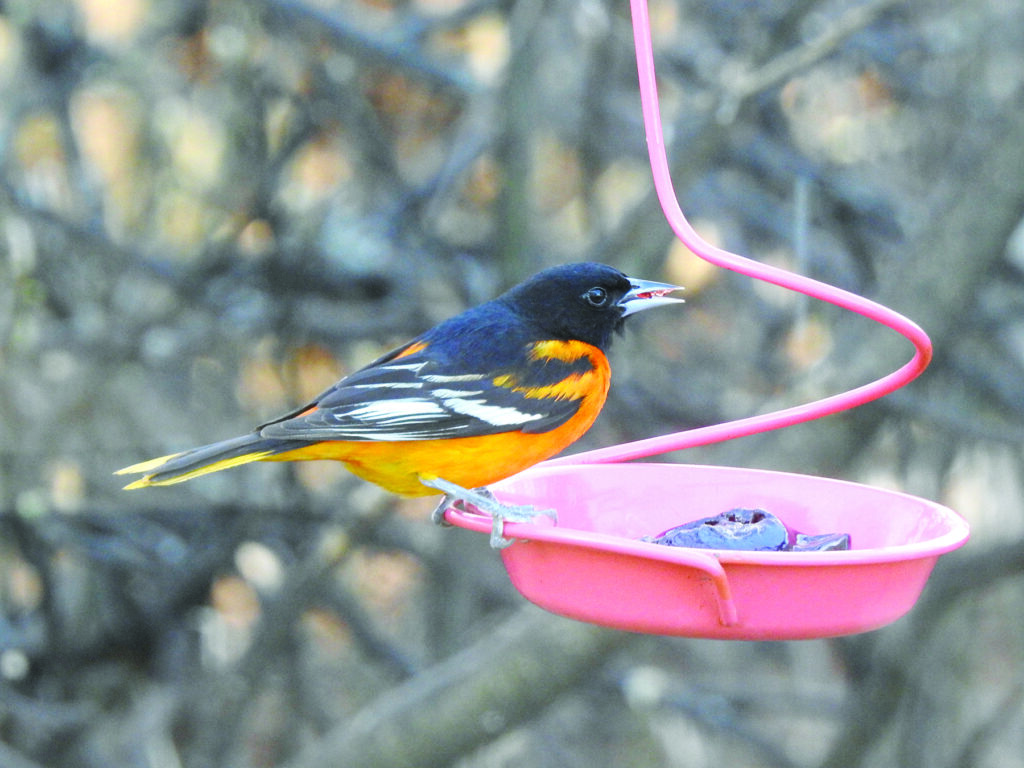

Feathered Friends
Being such an avid bird lover people often ask me what my favourite bird is. That is a hard one to answer because I find something wonderful in all birds but, I must say there is one bird that I quite adore and look so forward to seeing each spring, the oriole. Their brilliant plumage and even brighter song is something I literally start dreaming about as spring approaches. They are such an exciting bird to see and to have them regularly visiting your own backyard is just such an honour.
The most common oriole is the Baltimore oriole, but the Orchard oriole is another specie sometimes seen at birdfeeders. The male Baltimore oriole is most known for its flaming orange color with a contrasting black hood and wings which also have two white bars across them. The female and juveniles are paler in colour with a yellow-orange plumage and grayish wings and head. Their preferred habitat includes areas in and out of the city with mature trees, especially elms. In fact, Dutch elm disease has played a suspected role in their decline as American Elms are one of their favourites for nesting although they do also use Maple trees and Cottonwoods.
Nesting season begins with the male singing loudly to stake his territory and to attract a female. When one arrives, the male begins his courtship by facing the female, standing tall, then bowing up and down with his tail fanned out and wings spread. Once a female accepts a male, she begins the construction of an elaborate hanging pouch for a nest. She gathers grass, plants, bark, moss, and even animal hair to weave the pouch onto a branch 20 feet or higher from the ground. The female lays 3-6 eggs that are pale in colour with dark speckles. She will incubate for 12 to 14 days and once the young hatch, both parents feed them until they are ready to fledge in another 12 to 14 day period.
Orioles have a varied diet and are very beneficial in eating nuisance insects and they aid in pollination of many trees. They eat berries, blossoms, flower nectar, beetles, spiders, grasshoppers, wasps, and mass amounts of tent caterpillars which can be devastating to tree foliage. Orioles are known for eating in a manner called 'gaping'. When they find ripe, juicy fruit, they will stab it with their beak and drink up the juice with their textured tongue.

Male Orchard orioles are the smallest of North American orioles and have a deep chestnut colour rather than the bright orange of the Baltimore. Females are a combo of olive green and yellow and juvenile males are the same colour but with a black bib on the chest. Unlike the Baltimore, Orchard orioles will sometimes nest in groups in the same tree. Orchard orioles are also eager to get through nesting season, they arrive in May and are often heading back to South America by mid-July compared to Baltimore's who can be around until September.
To attract orioles to your feeding station you can offer several foods. First, there are nectar feeders that are similar to a hummingbird feeder but designed to accommodate the size of an oriole. In these, you can prepare a sugar water solution of four parts water to one part sugar which is suitable to both hummingbirds and orioles. No other sweeteners or artificial colour is recommended. Change it weekly at a minimum but in hot weather two to three times per week is better. Another food choice is fresh oranges. There are feeders designed to mount a half of an orange on so the oriole can perch and pick the fruit out of the rind. The next food choice is an odd one to some people, but it is without a doubt the favourite, grape jelly. Again, there are feeders to offer this and some are designed to offer the oranges and jelly together. I have gone through as many as 50 jars of jelly in a season and have witnessed some amazing things at jelly feeders including parents bringing their young to jelly and teaching them how to eat. Jelly and orange feeders can also attract many varieties of warblers, Gray Catbirds, and even Rose-breasted grosbeaks to name a few. Another great attraction for orioles is a water source. Whether it's a basic bird bath or an actual water feature/fountain you will see some serious use from orioles. They really enjoy the water for both drinking and bathing and on hot summer days expect to see multiple visits.
These feeders should be put up in early May to attract them as they arrive. If feeding birds is not possible for you, take the time to visit a park or take a river walk and look up into the treetops to hopefully see that beautiful orange flash of an oriole and to hear their glorious call. They really are a bird worth dreaming about!
Sherrie Versluis owns the Preferred Perch and is an avid birder.


